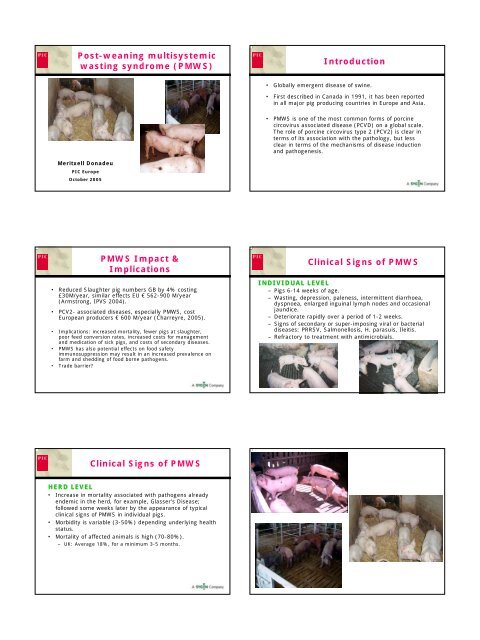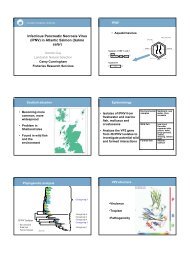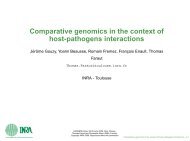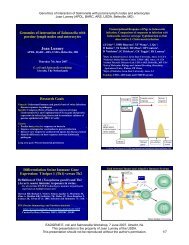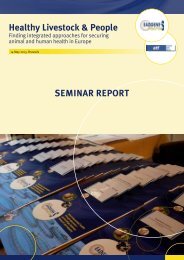Post-weaning multisystemic wasting syndrome (PMWS) Introduction ...
Post-weaning multisystemic wasting syndrome (PMWS) Introduction ...
Post-weaning multisystemic wasting syndrome (PMWS) Introduction ...
Create successful ePaper yourself
Turn your PDF publications into a flip-book with our unique Google optimized e-Paper software.
<strong>Post</strong>-<strong>weaning</strong> <strong>multisystemic</strong><br />
<strong>wasting</strong> <strong>syndrome</strong> (<strong>PMWS</strong>)<br />
<strong>Introduction</strong><br />
• Globally emergent disease of swine.<br />
• First described in Canada in 1991, it has been reported<br />
in all major pig producing countries in Europe and Asia.<br />
• <strong>PMWS</strong> is one of the most common forms of porcine<br />
circovirus associated disease (PCVD) on a global scale.<br />
The role of porcine circovirus type 2 (PCV2) is clear in<br />
terms of its association with the pathology, but less<br />
clear in terms of the mechanisms of disease induction<br />
and pathogenesis.<br />
Meritxell Donadeu<br />
PIC Europe<br />
October 2005<br />
<strong>PMWS</strong> Impact &<br />
Implications<br />
• Reduced Slaughter pig numbers GB by 4% costing<br />
£30M/year, similar effects EU € 562-900 M/year<br />
(Armstrong, IPVS 2004).<br />
• PCV2- associated diseases, especially <strong>PMWS</strong>, cost<br />
European producers € 600 M/year (Charreyre, 2005).<br />
• Implications: increased mortality, fewer pigs at slaughter,<br />
poor feed conversion rates, increased costs for management<br />
and medication of sick pigs, and costs of secondary diseases.<br />
• <strong>PMWS</strong> has also potential effects on food safety<br />
immunosuppression may result in an increased prevalence on<br />
farm and shedding of food borne pathogens.<br />
• Trade barrier?<br />
Clinical Signs of <strong>PMWS</strong><br />
INDIVIDUAL LEVEL<br />
– Pigs 6-14 weeks of age.<br />
– Wasting, depression, paleness, intermittent diarrhoea,<br />
dyspnoea, enlarged inguinal lymph nodes and occasional<br />
jaundice.<br />
– Deteriorate rapidly over a period of 1-2 weeks.<br />
– Signs of secondary or super-imposing viral or bacterial<br />
diseases: PRRSV, Salmonellosis, H. parasuis, Ileitis.<br />
– Refractory to treatment with antimicrobials.<br />
Clinical Signs of <strong>PMWS</strong><br />
HERD LEVEL<br />
HERD LEVEL<br />
• Increase in mortality associated with pathogens already<br />
endemic in the herd, for example, Glasser’s Disease;<br />
followed some weeks later by the appearance of typical<br />
clinical signs of <strong>PMWS</strong> in individual pigs.<br />
• Morbidity is variable (3-50%) depending underlying health<br />
status.<br />
• Mortality of affected animals is high (70-80%).<br />
– UK: Average 18%, for a minimum 3-5 months.
Mortality over time<br />
Herd A: poor general health status<br />
Mortality over time<br />
Herd B: high general health status<br />
% Mortality 7-30kg<br />
70<br />
60<br />
50<br />
40<br />
30<br />
20<br />
10<br />
0<br />
21/09/2000<br />
05/10/2000<br />
Waddilove 2001<br />
19/10/2000<br />
02/11/2000<br />
16/11/2000<br />
30/11/2000<br />
14/12/2000<br />
28/12/2000<br />
11/01/2001<br />
25/01/2001<br />
08/02/2001<br />
22/02/2001<br />
08/03/2001<br />
22/03/2001<br />
05/04/2001<br />
19/04/2001<br />
mortality<br />
20%<br />
18%<br />
16%<br />
14%<br />
12%<br />
10%<br />
8%<br />
6%<br />
4%<br />
2%<br />
0%<br />
Donadeu 2002<br />
Jan<br />
Feb<br />
March<br />
April<br />
May<br />
June<br />
July<br />
August<br />
Sept<br />
Oct<br />
Nov<br />
Dec<br />
Diagnosis of <strong>PMWS</strong><br />
Diagnosis of <strong>PMWS</strong><br />
Individual level: (Evolved from Sorden et al, 2000)<br />
• 3 components: all must be present in the<br />
following order and in the same pig:<br />
1- Clinical signs, including <strong>wasting</strong>.<br />
2- Gross pathological findings, including emaciation, and<br />
usually lymphadenopathy.<br />
3- Demonstration of the presence of PCV2 in pathological<br />
lesions by IHC or ISH (moderate to high amounts of<br />
PCV2).<br />
• At field level, not always going to step 3.<br />
• The definition per-se, involves PCV2.<br />
• Difference between PCV2 presence and PCV2 disease.<br />
Herd level:<br />
• Various criteria. Proposed from Segales et al, 2004:<br />
1- Clinical process, characterised mainly by <strong>wasting</strong>, in<br />
excess of the expected level. Evaluation of historical<br />
data. Increased mortality of 5%?<br />
2- Confirmation of <strong>PMWS</strong> in individual cases. Presence<br />
and prevalence of other pathogens that could result in<br />
differential diagnoses should also be assessed.<br />
• No response to treatment.<br />
• Increased mortality over a period of time.<br />
Control and Prevention<br />
1- Management Strategies<br />
Why is <strong>PMWS</strong> so difficult to control?<br />
1- Dealing with the unknown: how does the casual<br />
agent behave, how it spreads, how interacts with<br />
the immune system…. “Best guess available”<br />
2- Diagnosis: over and under diagnosis<br />
3- Big problem, so different strategies at used at the same<br />
time.<br />
4- Information available: majority circumstantial evidence,<br />
difficult to separate facts, beliefs and opinions.<br />
5- Clinical trials difficult to perform under field conditions.<br />
Objective: CONTROL<br />
a- 20 Madec points. Good Management practices:<br />
• Basics of pig management: strict AI/AO, limit stress, reduce<br />
stocking densities and strict hygiene. Minimum 16 points for<br />
significant response.<br />
PRACTICAL RECOMMENDATIONS AT FARM LEVEL:<br />
1- Minimize stress: Environmental, nutritional, emotional and<br />
immunological stress.<br />
2- Start best quality piglets: Ensure colostrum intake, delay<br />
<strong>weaning</strong>.<br />
3- Minimize secondary problems: Improve hygiene, Control other<br />
diseases present in the herd. Review current medication practices.
1- Management Strategies<br />
4- Therapeutic strategies & other diseases<br />
b- Batch farrowing:<br />
c- Partial depopulation<br />
d- Total Depopulation/repopulation:<br />
2- Nutritional Strategies<br />
e- Bioflavonoids, Vit E, Se, antioxidants: Nutraceutical products. Not<br />
very successful.<br />
3- Genetics<br />
f- Breed susceptibility/resistance:<br />
Changing the boar led to an improvement. Pietrain and Hampshire<br />
based lines are the most preferred options. Change in boar might<br />
mean change in source.<br />
g- Vaccination for PCV2:<br />
• “Circovac”: Merial is marketing a new PCV2 vaccine since last Autumn.<br />
• Provisional registration in France (Nov 04) and some regions of<br />
Germany (August to Dec 04). Intended for gilts and sows to provide<br />
passive immunity to piglets.<br />
• Iowa state: Chimeric PCV 2 and PCV1. Finisher pigs.<br />
• Autogenous vaccines<br />
h - Serotherapy:<br />
Originally in flat decks but later also in the farrowing house.<br />
First used to decrease incidence, but also to treat pigs already showing<br />
disease.<br />
i- Closed herd<br />
j- take replacements from <strong>PMWS</strong> positive farms.<br />
And many other measures have been tried…<br />
<strong>PMWS</strong> has a major impact for the European industry and a<br />
better understanding of the disease is needed in order to<br />
reduce it.<br />
• Standard biosecurity approaches do not appear to have<br />
prevented the entry of <strong>PMWS</strong>. How can we protect the<br />
units?<br />
• How can we make a more accurate and faster diagnosis?<br />
• How can we control <strong>PMWS</strong> in a consistent way?<br />
• Interactions of <strong>PMWS</strong> with other diseases?<br />
• How can we know when the farm is stable for the<br />
disease? How can we obtain negative animals from positive<br />
farms?<br />
• …


